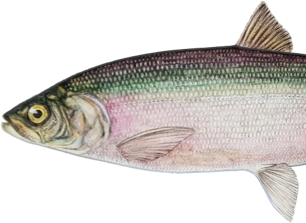Lake Status
Coregonines were once abundant in every lake, but multiple stressors over the past century have reduced their densities and distribution. The status of coregonines in each Great Lake is described below, including whether there are active restoration efforts underway.

Click on a Great Lake below to learn more about the status of coregonines and whether any active restoration is underway.
Lake Superior currently has the most diverse and intact assemblage of coregonines of all the Great Lakes. Likewise, although some of its habitat has been degraded over the past centuries, it is healthier than all of the other lakes and provides abundant coldwater habitat for coregonines.
Although active restoration or conservation is not occurring in Lake Superior, researchers are evaluating whether coregonine species that only exist in Lake Superior, such as Kiyi, could be reintroduced into other lakes. For example, the timing of when Kiyi reproduce has recently been documented. New research is seeking to determine whether Kiyi can be successfully reared in the lab.
Lake Huron (similar to Lake Michigan) was once home to the most diverse assemblage of coregonines.Similar to the other Great Lakes, overharvest, habitat degradation, and invasive species led to the extirpation of many of those species and the extinction of Longjaw Cisco and Deepwater Cisco.
Currently, only Cisco, Bloater, Lake Whitefish, and Round Whitefish occur in the lake. Cisco, however, are largely restricted to the northern reaches of the Main Basin, the North Channel and Georgian Bay. Lake Whitefish are still found throughout the entire lake, but the fisheries yield has been declining over the last 20 years. Current coregonine research projects in Lake Huron are focused on identifying and understanding why Lake Whitefish are not reproducing better, understanding existing genetic diversity of several species, and identifying opportunities for habitat restoration activities. A large restoration project is also underway in Lake Huron, where Cisco are being reintroduced in Saginaw Bay where they were once dominant but have been locally extirpated since the 1950s.
Lake Michigan (similar to Lake Huron) was once home to the most diverse assemblage of coregonines. Similar to the other Great Lakes, overharvest, habitat degradation, and invasive species led to the extirpation of many of those species and the extinction of Longjaw Cisco and Deepwater Cisco.
Among the ciscoes, only two of eight species still occur: Bloater remain relatively abundant and widespread, but have declined since the 1980s when they once supported an active commercial fishery. Cisco were nearly extirpated in the 1950s, but those that persisted in the northern part of the lake have begun expanding since 2011; their distribution and abundance remains far below historical levels. There are no active cisco restoration efforts occurring in Lake Michigan.
Both whitefish species remain and Lake Whitefish continues to support a valuable commercial fishery despite declining yields over the past 2 decades.
Lake Erie Cisco once supported one of the largest freshwater fisheries in the world, harvesting more than 48 million pounds in 1918. Habitat destruction and overfishing led to the extirpation of Ciscoes by the 1960s. The only deepwater cisco in the lake, Longjaw Cisco, is now extinct.
Similar to Cisco, Lake Whitefish harvest was substantial in the first half of the 20th century, peaking at more than 7 million pounds in 1949. Once again, human stressors such as nutrient pollution worsened the environment and Lake Whitefish harvest markedly declined down to 0 by 1970.
As nutrient concentrations in Lake Erie began improving, Lake Whitefish recovered but their harvests only occasionally have exceeded 1 million pounds since 1990. In terms of active restoration efforts, fishery managers in Lake Erie recently approved an experimental plan to stock Ciscoes into the New York waters. Planning is underway, but the earliest the first fish would likely be reintroduced is around 2025.
Lake Ontario once supported four cisco species, but by the 1950s three of them were extirpated. Today, the lake supports Cisco, plus Lake Whitefish, yet the distribution and abundance of both species is only a fraction of what once occurred. Scientists are trying to determine the primary factor limiting the success of both species. Reduced ice cover and deteriorating spawning habitat both could be contributing factors. Likewise, Round Whitefish is very rare and has been assessed as “Threatened” in New York waters.
Lake Ontario has an active restoration effort for Bloater, which was one of the extirpated species. Since 2012, New York State Department of Environmental Conservation, Ontario Ministry of Natural Resources and Forestry, U.S. Fish and Wildlife Service, and the U.S. Geological Survey have collaborated to collect Bloater eggs from Lake Michigan, rear them in hatcheries, and reintroduce them into Lake Ontario. More than 1.8 million fish have been stocked so far, with more than 10 recaptured fish.
